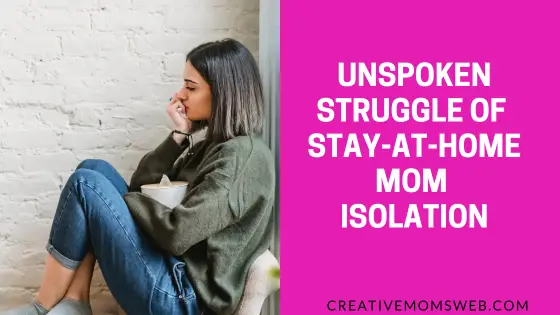Hey there, fellow moms! Today, I want to share a piece of my heart—the often unspoken struggle of stay-at-home mom isolation. It’s a real, raw part of this journey that deserves some spotlight. One of the most significant challenges many stay-at-home moms face is isolation. The feeling of being disconnected from the outside world and lacking adult interaction can take a toll on mental health and overall well-being.

Stay-at-home mom Isolation refers to the feeling of being disconnected, lonely, or socially isolated experienced by mothers who primarily stay at home to care for their children and manage household responsibilities. This isolation can stem from various factors inherent in the role of being a stay-at-home mom, including:
Real causes of stay-at-home mom isolation
Stay-at-home mom isolation is a multifaceted issue rooted in various factors that can contribute to feelings of loneliness and disconnection. While every mother’s experience is unique, some common causes of stay-at-home mom isolation include:
1. Lack of Adult Interaction
Spending the majority of the day caring for young children can result in limited opportunities for adult conversation and social interaction. Without regular contact with peers, stay-at-home moms may feel isolated and crave meaningful adult connections.
2. Loss of Identity:
Transitioning from a career-focused individual to a stay-at-home mom can lead to a loss of identity and a sense of purpose outside of caregiving responsibilities. This shift in roles may leave stay-at-home moms feeling disconnected from their pre-motherhood identities and interests.
3. Geographical or social barriers:
Some stay-at-home moms may live in areas where they have limited access to social support networks or community resources. Additionally, factors such as financial constraints or cultural norms may inhibit opportunities for socialization outside the home.
4. Emotional exhaustion:
Balancing the demands of childcare, household chores, and other responsibilities can be emotionally taxing. Over time, the relentless nature of caregiving without adequate breaks or support may contribute to feelings of isolation and burnout.
5. Perception of invisibility:
The work of stay-at-home moms is often undervalued and unrecognized by society. Without external validation or acknowledgment for their contributions, stay-at-home moms may feel invisible and unappreciated, leading to a sense of isolation.
6. Comparison and self-doubt:
Social media and societal expectations can exacerbate feelings of isolation among stay-at-home moms. Comparing oneself to others, particularly through carefully curated portrayals on social media, can fuel self-doubt and amplify feelings of inadequacy and isolation.
7. Limited time for self-care:
Juggling childcare and household responsibilities leaves little time for self-care activities that promote well-being and alleviate stress. Without opportunities to prioritize their own needs and recharge, stay-at-home moms may experience heightened feelings of isolation and overwhelm.
8. Changes in social dynamics:
Becoming a stay-at-home mom often involves significant shifts in social dynamics and friendships. Relationships with friends who are not parents may change as priorities and lifestyles diverge, leading to feelings of isolation and loneliness.
Strategies for Combatting Stay-at-Home Mom Isolation
Building Community:
One of the most effective ways to combat isolation as a stay-at-home mom is to build a supportive community around you. This can be done both online and offline. Joining parenting groups, either in your local area or on social media platforms, can provide a sense of belonging and connection with other moms who are going through similar experiences. Attend playdates, join mom meetups, or participate in parenting classes or workshops to meet other moms in your area. Additionally, consider reaching out to friends and family members for regular social interactions or forming a support group with other stay-at-home moms in your neighborhood.
Prioritizing Self-Care:
Self-care is essential for every mom, but it’s often neglected when caring for young children. As a stay-at-home mom, it’s crucial to prioritize self-care to maintain your physical, emotional, and mental well-being. Carve out time each day for activities that recharge you, whether it’s taking a long bath, practicing yoga, reading a book, or going for a walk. Ask for help from your partner, family members, or friends to take care of the children while you take some time for yourself. Remember that self-care isn’t selfish; it’s necessary for being the best mom you can be.
Seeking Professional Help:
If feelings of isolation persist and begin to impact your mental health, don’t hesitate to seek professional help. Therapy can provide a safe and supportive space to explore your feelings, learn coping strategies, and develop skills to manage stress and anxiety. A therapist can also help you address any underlying issues contributing to your sense of isolation and provide guidance on how to build a more fulfilling life as a stay-at-home mom.
Finding Virtual Support:
In today’s digital age, there are numerous online resources and communities specifically designed for stay-at-home moms. Joining online forums, Facebook groups, or virtual support networks can provide a sense of connection and camaraderie with other moms, even if you’re unable to leave the house. These online communities offer a platform to share experiences, seek advice, and offer support to one another, helping to alleviate feelings of isolation and loneliness.
Engage in hobbies or interests:
Pursue hobbies or interests that bring you joy and fulfillment outside of your role as a mom. Whether it’s joining a book club, taking up a new hobby like gardening or painting, or participating in a fitness class, engaging in activities you love can help you meet new people and break the cycle of isolation.
So, here’s the truth: stay-at-home mom isolation is a real struggle, but it’s not the end of the story. Acknowledge it, seek connection, practice self-care, and break the silence. We’re in this together, navigating the quiet storm one day at a time.
